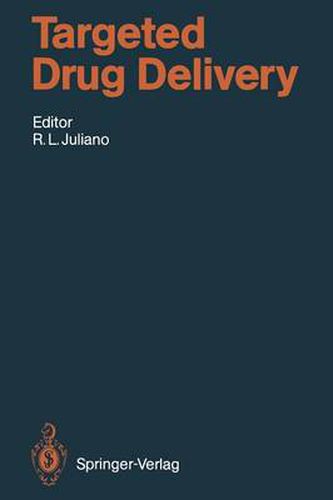Readings Newsletter
Become a Readings Member to make your shopping experience even easier.
Sign in or sign up for free!
You’re not far away from qualifying for FREE standard shipping within Australia
You’ve qualified for FREE standard shipping within Australia
The cart is loading…






This title is printed to order. This book may have been self-published. If so, we cannot guarantee the quality of the content. In the main most books will have gone through the editing process however some may not. We therefore suggest that you be aware of this before ordering this book. If in doubt check either the author or publisher’s details as we are unable to accept any returns unless they are faulty. Please contact us if you have any questions.
The chapters in this volume describe a powerful emerging approach for the therapy of disease. Targeted drug delivery, that is control of the kinetic behavior, tissue distribution, and subcellular localization of pharmaco logically active agents, offers an important means for improving the efficacy of a wide variety of drug therapies. This is particularly true for therapeutic approaches based on newer agents which are the products of recombinant DNA research. These agents, be they peptides, proteins, or oligonucleotides, tend to be larger, more complex, and less stable than traditional drugs. Thus they stand to benefit most from drug delivery systems which can protect them from premature degradation and which can carry them to critical target sites in the body. This volume examines several important aspects of the current state of drug delivery research; it also attempts to project future directions for this field. Successful approaches to drug targeting are based, first of all, on a sophisticated understanding of the biological barriers encountered by the drug-carrier complex as it moves from the portal of administration to the ultimate target site. A second aspect of successful drug delivery is appro priate matching of the disease entity with the pharmacologically active substance and with the delivery system. Thus it is important to be aware of the variety of delivery technologies which currently exist and to be sensitive to their strengths and limitations.
$9.00 standard shipping within Australia
FREE standard shipping within Australia for orders over $100.00
Express & International shipping calculated at checkout
This title is printed to order. This book may have been self-published. If so, we cannot guarantee the quality of the content. In the main most books will have gone through the editing process however some may not. We therefore suggest that you be aware of this before ordering this book. If in doubt check either the author or publisher’s details as we are unable to accept any returns unless they are faulty. Please contact us if you have any questions.
The chapters in this volume describe a powerful emerging approach for the therapy of disease. Targeted drug delivery, that is control of the kinetic behavior, tissue distribution, and subcellular localization of pharmaco logically active agents, offers an important means for improving the efficacy of a wide variety of drug therapies. This is particularly true for therapeutic approaches based on newer agents which are the products of recombinant DNA research. These agents, be they peptides, proteins, or oligonucleotides, tend to be larger, more complex, and less stable than traditional drugs. Thus they stand to benefit most from drug delivery systems which can protect them from premature degradation and which can carry them to critical target sites in the body. This volume examines several important aspects of the current state of drug delivery research; it also attempts to project future directions for this field. Successful approaches to drug targeting are based, first of all, on a sophisticated understanding of the biological barriers encountered by the drug-carrier complex as it moves from the portal of administration to the ultimate target site. A second aspect of successful drug delivery is appro priate matching of the disease entity with the pharmacologically active substance and with the delivery system. Thus it is important to be aware of the variety of delivery technologies which currently exist and to be sensitive to their strengths and limitations.